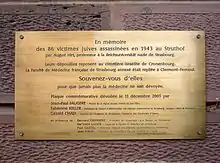
The Reichsuniversität Straßburg was founded in 1941 by the Nazis in Alsace after the annexation of Alsace-Lorraine by Nazi Germany. The University of Strasbourg had moved to Clermont-Ferrand in 1939. The university's purpose was to restore the German character of the Kaiser-Wilhelm-Universität, as the University of Strasbourg was named from 1872 to 1918, and to advance "German knowledge" in the annexed territory. When the Allies arrived in Alsace in 1944, the Reichsuniversität was first transferred to Tübingen and then dissolved.
History

"In memory of the 86 Jewish victims assassinated in 1943 at Struthof by August Hirt, professor at the Nazi Reichsuniversität of Strasbourg.
Their remains rest in the Israelite cemetery in Cronenbourg.
The French Faculty of Medicine of annexed Strasbourg had moved to Clermont-Ferrand.
Remember them so that medicine may never again go astray."
The University of Strasbourg evacuated to Clairmont-Ferrand in 1939, in advance of the Nazi invasion.[1] The Reichsuniversität Straßburg was formally opened in the university's facilities on 23 November 1941, the last of three "Reich Universities"; the other two were in occupied Poland.[2] It was intended to advance and spread German learning as defined by the Nazis, and to eclipse the Sorbonne.[3] Most of the faculty and students fled when the Allies re-entered the city in November 1944.[3]
Academics
The initial organisation of the Reichsuniversität was overseen by Ernst Anrich, a historian who became Dean of the Faculty of Philosophy. An SS man, he sought to orient it closely with the Nazi Party, the SS, and the Ministry of Education.[4]
The university had four of the traditional faculties: Philosophy (i.e., Humanities), Law, Medicine and Science, but no division of Theology.[5] An independent institute of religion (Allgemeine Religionswissenschaft) within the department of early history and antiquities was presided over by Otto Huth, head of the section on Indo-European religion within the Ahnenerbe, the academic and research division of the SS.[6][7] The institute had as one of its purposes bolstering the case for Alsace belonging culturally to Germany.[8]
The Faculty of Natural Science at the Reichsuniversität Straßburg was particularly important to the Ahnenerbe.[9] In particular, the Faculty of Medicine was more involved in the war effort than at the other two Reich universities.[10] August Hirt, subsequently convicted as a war criminal, headed the Institute of Anatomy, where he conducted "racial anatomy" experiments and murdered concentration camp inmates for the Ahnenerbe's Jewish skeleton collection and his own Jewish skull collection.[11] Victims were selected at Auschwitz as well as at the nearby Natzweiler-Struthof camp, and put to death in the gas chambers at Struthof, which had originally been installed for chemical weapons experiments.[12] Hirt also had corpses delivered to the institute from French hospitals, POW hospitals, and from executions of French civilians.[13] In addition to chemical weapons, criminal research on typhus was also conducted at the university.[1] In 2016 the University of Strasbourg commissioned an investigation of medical crimes committed at the Reichsuniversität, and the report was published in May 2022.[1][14][15]
Notable people
- Hans Bender[5]
- Otto Bickenbach[1]
- Rudolf Fleischmann[16]
- Günther Franz[17]
- Eugen Haagen[1]
- August Hirt
- Kurt Hofmeier[18]
- Ernst Rudolf Huber[3]
- Otto Huth
- Anton Kiesselbach[19]
- Georg Niemeier[9]
- Walter Noddack[20]|
- Johannes Stein[3]
- Carl Friedrich von Weizsäcker[3]
- Joachim Werner (archaeologist)[21]
- Karl Wimmer[19]
References
- 1 2 3 4 5 Aurelien Breeden (24 July 2022). "A French University Confronts Medical Crimes and Its Nazi Past". The New York Times. Archived from the original on 24 July 2022.
- ↑ Teresa Wróblewska (2000). Die Reichsuniversitäten Posen, Prag und Strassburg als Modelle nationalsozialistischer Hochschulen in den von Deutschland besetzten Gebieten (in German). Toruń: Adam Marszałek. p. 221. ISBN 9788371746741.
- 1 2 3 4 5 "Forschung und Verbrechen" (with documentary film) (in German). 18 December 2018.
- ↑ Michael H. Kater (2006). Das "Ahnenerbe" der SS 1935-1945: Ein Beitrag zur Kulturpolitik des Dritten Reiches. Studien zur Zeitgeschichte (in German). Vol. 6 (4th ed.). Munich: Oldenbourg. p. 286. ISBN 978-3-486-57950-5.
- 1 2 Frank-Rutger Hausmann (2006). Hans Bender (1907–1991) und das "Institut für Psychologie und Klinische Psychologie" an der Reichsuniversität Strassburg 1941–1944. Grenzüberschreitungen (Institut für Grenzgebiete der Psychologie und Psychohygiene) (in German). Würzburg: Ergon. p. 15. ISBN 9783899135305.
- ↑ Horst Junginger (2008). "Otto Huth". In Ingo Haar; Michael Fahlbusch (eds.). Handbuch der völkischen Wissenschaften: Personen, Institutionen, Forschungsprogramme, Stiftungen (PDF) (in German). Munich: Saur. p. 320. ISBN 9783598117787.
- ↑ Kater, p. 287.
- ↑ Horst Junginger (2008). "Introduction". In Horst Junginger (ed.). The Study of Religion under the Impact of Fascism. Numen Book Series: Studies in the History of Religions. Vol. 117. Leiden / Boston: Brill. p. 25. ISBN 978-90-04-16326-3.
- 1 2 Julien Reitzenstein (2018). Das SS-Ahnenerbe und die »Straßburger Schädelsammlung« – Fritz Bauers letzter Fall. Zeitgeschichtliche Forschungen (in German). Vol. 52. Berlin: Dunckler & Humblot. pp. 70–71. ISBN 978-3-428-55313-6.
- ↑ Wróblewska, p. 123.
- ↑ Patrick Wechsler (1991). La Faculté de médecine de la 'Reichsuniversität Strassburg' (1941–1945) à l'heure nationale-socialiste (PhD, medicine) (in French). University of Strasbourg. OCLC 1136994009.
- ↑ Sören Flachowsky; Rüdiger Hachtmann; Florian Schmaltz, eds. (30 January 2017). Ressourcenmobilisierung: Wissenschaftspolitik und Forschungspraxis im NS Herrschaftssystem (in German). Wallstein Verlag. p. 519. ISBN 9783835340046.
- ↑ Raphael Toledano (May 2016). "Anatomy in the Third Reich – The Anatomical Institute of the Reichsuniversität Strassburg and the deliveries of dead bodies". Annals of Anatomy. 205: 128–44. doi:10.1016/j.aanat.2016.03.006. PMID 27060203.
- ↑ Georges Yoram Federmann. "Le Cercle Menachem Taffel". judaisme.sdv.fr (in French).
- ↑ Niklas Bender (23 June 2022). "Reichsuniversität Straßburg ließ Häftlinge ermorden". Frankfurter Allgemeine Zeitung (in German).
- ↑ Burghard Weiss (2006). "Der Kernphysiker Rudolf Fleischmann und die Medizin an der Reichsuniversität Straßburg (1941–1944)". NTM Journal of the History of Science, Technology and Medicine (in German). 14: 107–18.
- ↑ Klee, Ernst (2005). Das Personenlexikon zum Dritten Reich. Wer war was vor und nach 1945. Frankfurt am Main: Aktualisierte Ausgabe. p. 161.
- ↑ Aisling Shalvey (2022). "Career, Proximity to National Socialism, and Post-War Reception of Dr Kurt Hofmeier, Director of the Children's Clinic at the Reichsuniversität Straßburg (1941–1944)". Revue d'Allemagne et des pays de langue allemande. 54 (1): 253–68. doi:10.4000/allemagne.3050. S2CID 251169177.
- 1 2 Kater, p. 248.
- ↑ Brigitte Van Tiggelen (2019). "Ida Noddack, the Eka-Manganeses and Nuclear Fission". In Annette Lykknes; Brigitte Van Tiggelen (eds.). Women In Their Element: Selected Women's Contributions To The Periodic System. Singapore: World Scientific. pp. 219–20. ISBN 978-981-120-628-3.
- ↑ Hubert Fehr (2001). "Hans Zeiss, Joachim Werner und die archäologischen Forschungen zur Merowingerzeit". In Heiko Steuer (ed.). Eine hervorragend nationale Wissenschaft: deutsche Prähistoriker zwischen 1900 und 1995. Ergänzungsbände zum Reallexikon der germanischen Altertumskunde (in German). Vol. 29. Berlin: De Gruyter. p. 346. ISBN 9783110864595.
Further information
- Horst Kant (1997). "Zur Geschichte der Physik an der Reichsuniversität Strassburg in der Zeit des Zweiten Weltkrieges" (PDF) (in German). Max Planck Institut für Wissenschaftsgeschichte. Archived from the original (PDF) on 2015-12-01.
- Herwig Schäfer (1999). Juristische Lehre und Forschung an der Reichsuniversität Straßburg 1941–1944. Beiträge zur Rechtsgeschichte des 20. Jahrhunderts (in German). Vol. 23. Tübingen: Mohr Siebeck. ISBN 9783161470974.
- Joachim Lerchenmüller (2004). "Die Reichsuniversität Straßburg: SD-Wissenschaftspolitik und Wissenschaftlerkarrieren vor und nach 1945". In Karen Bayer; Frank Sparing; Wolfgang Woelk (eds.). Universitäten und Hochschulen im Nationalsozialismus und in der frühen Nachkriegszeit (in German). Stuttgart: Steiner. pp. 53–79. ISBN 9783515081757.
- Christian Baechler; François Igersheim; Pierre Racine, eds. (2005). Les Reichsuniversitäten de Strasbourg et de Poznan et les résistances universitaires - 1941–1944. Les Mondes germaniques. Strasbourg: University of Strasbourg. ISBN 978-2868202680. (in French and German)
- Elisabeth T. Crawford; Josiane Olff-Nathan, eds. (2005). La Science sous influence: l'université de Strasbourg enjeu des conflits franco-allemands, 1872–1945 (in French). Strasbourg: Nuée Bleue. ISBN 9782716506441.
- Frank W. Stahnisch (2016). "Die Neurowissenschaften in Straßburg zwischen 1872 und 1945: Forschungstätigkeiten zwischen politischen und kulturellen Zäsuren". Sudhoffs Archiv (in German). 100 (2): 227–62. doi:10.25162/sudhoff-2016-0011. JSTOR 24913789. S2CID 211445792.
- Kirsten Esch (2018). Forschung und Verbrechen: Die Reichsuniversität Straßburg (documentary film, 42 mins, 34 secs) (in German). Deutsche Welle DokuFilm.
- Rainer Möhler (2020). Die Reichsuniversität Straßburg 1940–1944: eine nationalsozialistische Musteruniversität zwischen Wissenschaft, Volkstumspolitik und Verbrechen. Veröffentlichungen der Kommission für geschichtliche Landeskunde in Baden-Württemberg, Reihe B: Forschungen (in German). Vol. 227. Stuttgart: Kohlhammer. ISBN 9783170380981.
- "The Reichsuniversität Straßbourg (1941-1944): Results of the research by the Historical Commission into the history of the Medical Faculty". University of Strasbourg.
- Christian Bonah; Florian Schmaltz; Paul Weindling, eds. (1 May 2022). "La Faculté de médecine de la Reichsuniversiät Straßburg et l'hôpital civil sous l'annexion de fait nationale-socialiste 1940–1945. Rapport final de la Commission historique pour l'histoire de la faculté de médecine de la Reichsuniversität Straßburg 2017–2022" (PDF) (in French). University of Strasbourg.
- Aisling Shalvey (2023). Pediatrics in the Reichsuniversität Straßburg: Children's Medicine at a Bastion of Nazi Ideology. University of Exeter. ISBN 9781804130896.